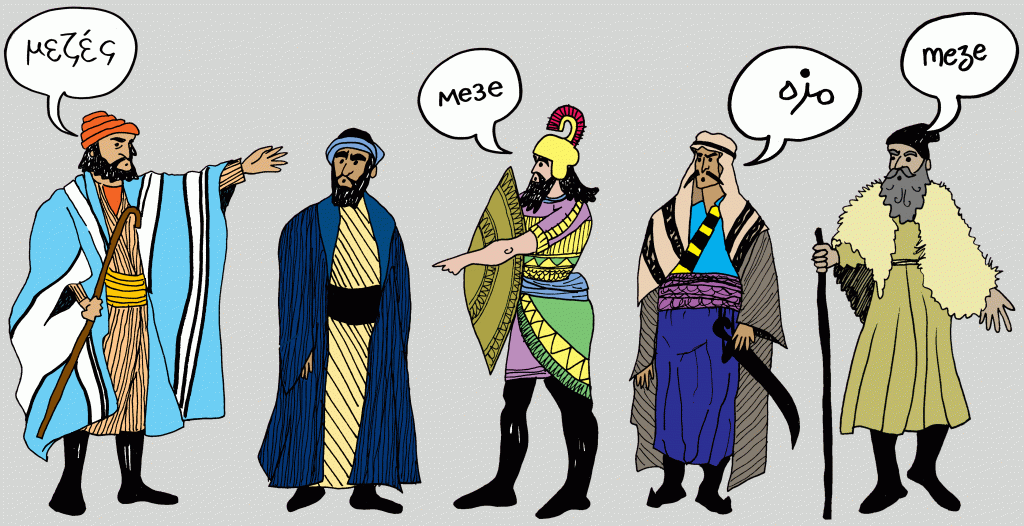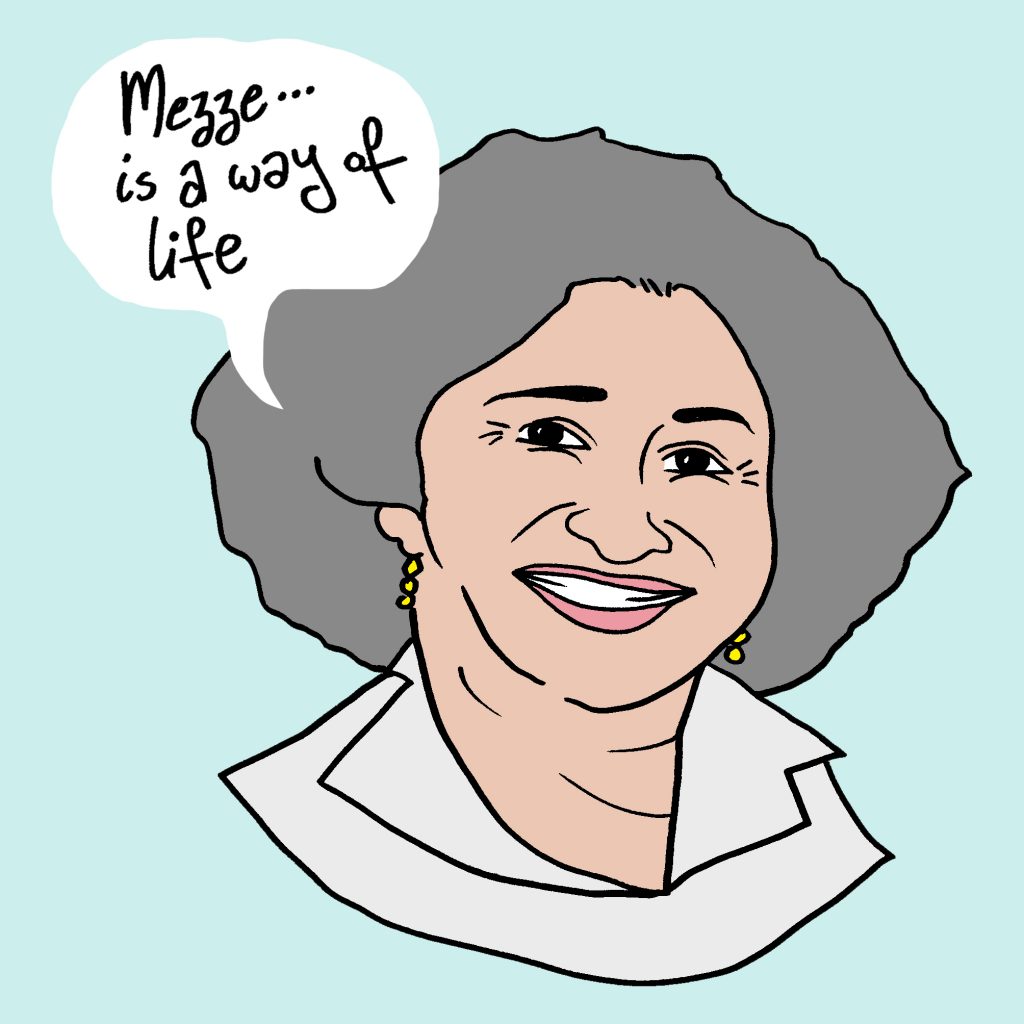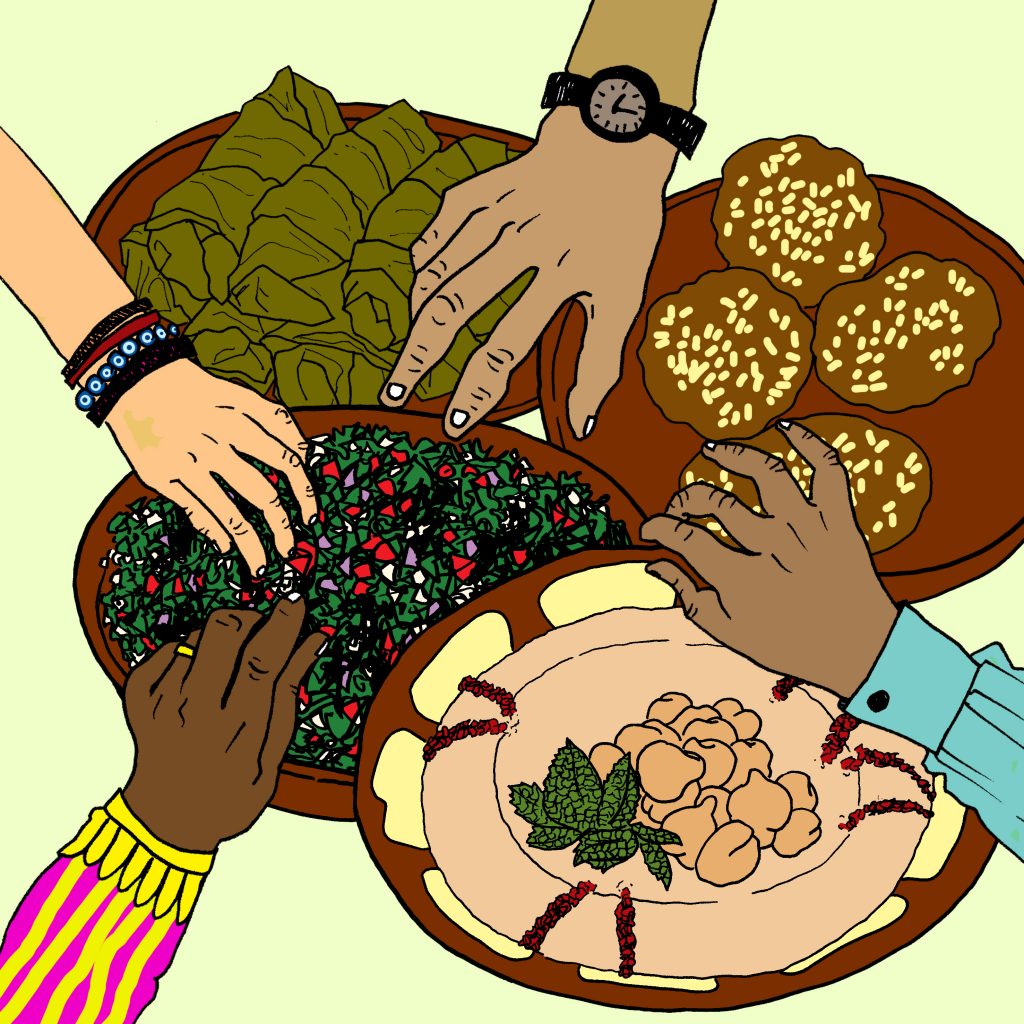The controversial kitchen
Making sense of mezze

Upon recapturing Jerusalem from the Crusaders in 1187, Salahuddin, then Sultan of Egypt and the Levant, decided to prepare a dish to commemorate the occasion. He ordered – or so the legend goes – the creation of a cold mixture of cooked and mashed chickpeas seasoned with olive oil, lemon juice and sesame seed paste. Anyone slightly familiar with Middle Eastern food would immediately recognise those ingredients as being integral components of the much-beloved hummus.
There is another take on that legend, stating that Salahuddin rather had the dish prepared for him once assuming power as Sultan of Egypt. Both versions are contested by other variations from across the Middle East and North Africa – these many legends around the birth of the dish indicate the centrality of hummus to regional culture.
However, not only hummus but rather the entire concept of mezze, the Middle Eastern form of appetizers, is mired in controversy and conflict, historically as well as today.

In 2008, the Association of Lebanese Industrialists (ALI) threatened to start an international legal action stopping Israel from marketing what they believed to be Lebanese foods, such as hummus and falafel. With the Israeli brand Sabra claiming as much as 60% of the US market share for hummus sales, the ALI was concerned that the chickpea dish would be seen as Israeli rather than Lebanese.
Sabra and its counterpart, Tribe Hummus, have also been targeted by the international Boycott, Divest and Sanctions (BDS) campaign because of their links to the Israeli military apparatus, which continues to bring devastation to Palestine. Still, the ALI’s move should rather be seen in the narrower context of the Lebanon-Israel conflict, as it has more to do with staking a claim on the specific “Lebaneseness” of hummus than its more general Arab belonging.
There is little chance of course to be able to trace exactly where in the Levant hummus was first made.
“But we Lebanese like to believe that it came from our own kitchens simply because we’re the best at making it,” says Elie Fares, behind the Lebanese blog A Separate State of Mind.
“In all seriousness though, the Israeli claim that they came up with hummus is nothing more than an attempt to airbrush the country’s ‘history’ and endow on it some form of heritage which it otherwise lacks,” he notes.
That back and forth mezze record-breaking between Israel and Lebanon came to be known as the “hummus wars.”
While the ALI’s threat in the end did not go far, Lebanon did not falter in its efforts to acquire hummus supremacy. In 2010, the village of al-Fanar just outside of Beirut created the world’s largest plate of the appetizer, weighing 11.5 tons. The dish, which was made of 8 tons of boiled chickpeas, 2 tons of tahini, 2 tons of lemon juice and 70 kilos of olive oil, beat that of the previous record holder, the Arab-Israeli village of Abu Gosh. Lebanon had previously held the same record, after creating a 2 ton dish in October 2009 – only to get beat by an Israeli 4 ton plate two months later. That back and forth mezze record-breaking came to be known as the “hummus wars.” To add to the mix, Lebanon also holds the world record for the largest fattoush (a salad made of toasted pita and mixed greens), weighing more than 4,432 kilos.
“The record-setting hummus contests are a little bit ridiculous, but the branding strategy is dead serious,” says Elias Muhanna, assistant professor of literature at Brown University and writer of the blog Qifa Nabki.
“The worldwide market for hummus is growing each year. Lebanon doesn’t manufacture weapons systems or GPS apps; we make hummus, hashish and other pleasurable concoctions. May as well try to brand them effectively,” he says.
Even though globally it is the most famed and popular mezze appetizer, hummus is by no means a solo player. Mezze is more than just a number of different food items; it represents the culture of people getting together at restaurants to share dishes ranging from deep-fried falafel balls and the iconic kibbeh (made of bulgur and stuffed with meat or spicy vegetable combinations) to cold dishes like stuffed vine leaves and moutabbal (a cousin to hummus, made from smoked aubergines).

“Mezze…is a way of life,” says food writer and chef Anissa Helou, who was born and raised between Beirut and the town of Mashta al-Helou in Syria. “When dining in typical Lebanese or Syrian restaurants, you can order as many as 20 different mezze dishes: dips, salads, savoury pastries, vegetable dishes, raw meat dishes and so on.”
In one of her articles, Helou quotes Ayla Algar, a Turkish cookbook author who traces the origins of mezze to ancient Persia and its name to the Persian word “maza”, which means to taste and relish. Today, mezze is a central part of food culture across the Mediterranean region, including in places like Lebanon, Syria, Turkey, Greece and the Balkans.
In 2010, Israeli artist Oreet Ashery and Palestinian artist Larissa Sansour explored another mezze-related question in a project called Falafel Road. Together, they facilitated public meals at various London falafel restaurants, where the main point of discussion was whether Israel stole the falafel from the Palestinians. Ashery and Sansour took a wandering path down the road of multiple national and regional interpretations of the dish and its place in the larger colonial context.
“The falafel has become [an] example of [an] appropriated or stolen national symbol” says Ashery.
“It is true that the ‘origins’ of the falafel is contested territory in the region,” he continues, “but none of that is relevant in this case because Israel’s proud claim of the falafel as one of its primary national dishes is not as much a case of cross-geo-cultural influence as it is of colonial theft.”
Ask any Egyptian and they will tell you that taamiyya is superior to falafel in every way, whether in relation to its nutrition, taste or history.
The origins of falafel are definitely mired in history. Some believe that the dish was created by Coptic Christian Egyptians centuries ago as an alternative to meat, which they abstained from during certain fasts. Another version tells of falafel being prepared as far back as Pharaonic Egypt, and eaten by those from lower classes in the urban areas.
In Egypt, falafel is made with fava beans and called taamiyya, and has a distinctive green colour from parsley and cilantro. Ask any Egyptian and they will tell you that taamiyya is superior to falafel in every way, whether in relation to its nutrition, taste or history. This is ironic since Cairo residents today can be heard complaining about the influx of falafel, tabbouleh and other not-so-Egyptian mezze into their cafés and restaurants. Older Cairo residents however, often deem these mezze cafes much better alternatives than the city’s burgeoning burger stands.

In the end, despite all of these disagreements, there are also ways in which mezze continues to connect people. One major example is how Syrian refugees keep their kibbeh-making traditions alive in their new homes – in places as far away as Canada, for example, where a catering enterprise was started and run by Syrian refugee women in Toronto.
“I think the one positive [thing] that came out of the war in Syria is the expansion of knowledge about Syrian food,” says Anissa Helou, who supports this enterprise.
“Making and eating food is a wonderful way of bringing people together. Also, significantly, food is culture, so passing on the knowledge about culinary traditions and history and how to make the dishes of the country are essential towards preserving the culture.”
In Lebanon, refugee women and Lebanese chefs have been meeting over the preparation of kibbeh in a community center established right at one of the country’s most hostile internal borders, dividing two politically opposing neighbourhoods in the northern city of Tripoli.
Mezze holds together a region stretching from the far western coast of North Africa to the Arabian Sea, and from the Balkans down to Yemen.
There are other small ways in which people use mezze to bridge divides, bringing people together rather than driving them apart. In 2015, a Jewish Israeli restaurateur tried one such endeavor by opening a hummus cafe north of Tel Aviv, which gave discounts to Jews and Arabs who came to eat together. Though a much-touted gesture, it is still hard to forget that a mere 100 kilometres away lies Gaza, where Israel restricted the supply of food items as basic as chickpeas, lentils and beans until 2009.
In 2011, before Syria fell deep into the throes of civil war, surprised residents in Damascus found anonymous baskets containing hummus, beans and dates on their doorsteps during Ramadan. At the bottom were leaflets calling for the fall of the regime and explaining the idea of democratic rule.
Conflict, it seems, is an inevitable guest to both the kitchen and dining table. What is exceptional about food, and mezze in particular, is its powerful ability to bring people together despite circumstances – even giving a sense of unity across seeming divides. Mezze holds together a region stretching from the far western coast of North Africa to the Arabian Sea, and from the Balkans down to Yemen. It does not silence disagreements or close controversial conversations – in fact, it often keeps them alive. But in the end, isn’t that what food is for?
This article is part of the Web Arts Resistances project and platform, coordinated by Babelmed in collaboration with Inkyfada, ONORIENT, Radio M and Tabasco video.






